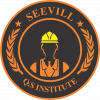Land Survey Course in Lucknow
Land Surveying
Land Surveying (land survey course in Lucknow) is a detailed surveying or surveying can be a scientific method by which we survey the land (horizontal distance, elevation, direction and angle) and collect information through surveying, observation and measuring the field, once the data is collected we simply confirm the property lines, this supports the look and design at the same time.
The Seevill Quantity Survey Institute provides comprehensive depth data on the land survey. how to know a specific line of sight how to get Boundary line draws how to find all legal areas of land. it is an on-site land management training course. We offer complete LAND data with live sorts and live projects.
The Seevill Quantity Survey Training Institute is the best surveying institute in Lucknow, so we offer practical and legal strategies to our students.
Major Survey Use in Field
There are three types of survey majorly used in Field
- Geodetic Survey
- Topographic Survey
- Cadastral Survey
Geodetic Survey
Geodetic Survey entails the size of a terribly massive place of the planet that should take into consideration the earth’s curvature. when they take into account the authentic curvature of the earth, these are very correct surveys. Geodetic Survey are used as vital references and surveyors can use that reference when surveyor will surveying smaller areas of land
Topographic Survey
Topographic Survey is consisting measurements of the vertical elevation of the floor being surveyed as properly as the synthetic constructions on it. Topographical surveys are extensively used by suggests that of Governments and corporations enticing in construction. Topographical Survey of land simply annexed with the help of a town which plans to construct roads and different infrastructure for monetary development.
Cadastral Survey
Cadastral surveys are carried out to decide the boundaries between parcels of actual estate, regardless of whether or not the land is in private or in public ownership. A Cadastral Survey determines the boundary that may be identified for all prison purposes. With the assistance of the Cadastral Survey, we are going to simply establish the property taxes or the region of the floor that will be transferred after we sell the property.

AUTO LEVEL
- SETTING UP THE TRIPOD
- CENTERING WITH OPTICAL PLUMMET
- LEVELLING
- FOCUSING THE TELESCOPE
- SETTING THE MEASUREMENT MODE AND PREPARING THE TARGET
- SETTING THE HORIZONTAL ANGLE
- SETTING TARGET HEIGHT AND INSTRUMENT HEIGHT
- SETTING THE STATION ELEVATION, CREATING A NEW JOB
- CHECKING AND ADJUSTING THE PLATE LEVEL, CIRCULAR LEVEL, OPTICAL PLUMMET
- TRIPOD SETTING, BUBBLE SETTING AND TILT SETTING
- CREATING NEW JOB/FILE, STATION, BACK SIGHT, FORE SIGHT AND POLE HANDLING
- MEASURING AND STORING POINTS, TAPE MEASUREMENT AND AREA SURVEY
- CHANGE POINT (CP) SHIFTING USING FORE SIGHT METHOD
- CHANGE POINT (CP) SHIFTING USING RESECTION METHOD, REM AND MLM
- SETTING OUT-USING COORDINATES
- SETTING OUT-USING DISTANCE AND ANGLE
- SETTING OUT-POINTS AT EQUAL LENGTH AND COLUMN MARKING
- LEVEL SHIFTING
- ANGLES AND AREA CALCULATION
TOTAL STATION
- SETTING UP THE TRIPOD
- CENTERING WITH OPTICAL PLUMMET
- LEVELLING
- FOCUSING THE TELESCOPE
- SETTING THE MEASUREMENT MODE AND PREPARING THE TARGET
- SETTING THE HORIZONTAL ANGLE
- SETTING TARGET HEIGHT AND INSTRUMENT HEIGHT
- SETTING THE STATION ELEVATION, CREATING A NEW JOB
- CHECKING AND ADJUSTING THE PLATE LEVEL, CIRCULAR LEVEL, OPTICAL PLUMMET
- TRIPOD SETTING, BUBBLE SETTING AND TILT SETTING
- CREATING NEW JOB/FILE, STATION, BACK SIGHT, FORE SIGHT AND POLE HANDLING
- MEASURING AND STORING POINTS, TAPE MEASUREMENT AND AREA SURVEY
- CHANGE POINT (CP) SHIFTING USING FORE SIGHT METHOD
ARCGIS
- INTRODUCTION TO ARCGIS
- DATA MANAGEMENT (RASTER DATA, VECTOR DATA, GEODATABASE, SHAPEFILES AND ATTRIBUTE QUERY)
- MAPPING AND VISUALIZATION (STYLING, MANAGING AND DISPLAYING LAYER)
- RASTER DATA ANALYSIS (SLOPE, HILLSHADE AND DEM)
- VECTOR DATA ANALYSIS (INTERSECT, BUFFER, UNION AND CLIP)
- GEO-STATISTICAL ANALYSIS TECHNIQUE (SPATIAL ANALYSIS AND NETWORK ANALYSIS
DGPS
- INTRODUCTION
- SETTING UP THE RECEIVER
- DATA TRANSFERRING
- GENERAL OPEARATION
- CABLE AND CONNECTORS
- BASE, ROVER, GPS CONNECTION AND SETTINGS
- GPS OPERATING AREA SURVEY
- DGPS SURVEY
- SETTING OUT
- DATA DOWNLOADING, DATA PROCESSING, CONVERTING DATA FORMAT INTO AUTOCAD FORMAT
Other Courses of Civil Engineering
Quantity Surveying Training- Learn The Basics
If you want to know about how to calculate quantities on a construction site and need to become a professional quantity surveyor, then our Quantity Survey Course is perfect for you! Get hands-on training from our experienced Quantity Surveyors and learn the basics of Quantity Surveying. Fill out the form on our website to get
Complete your Billing Engineering Knowledge
Whether you’re a consultant or a billing engineer, this billing engineering course will help you gain an expert understanding of the most prevalent types of invoices and their principles behind them. Register for the course and update your knowledge. Right Now.

